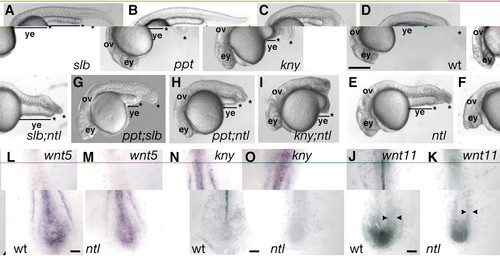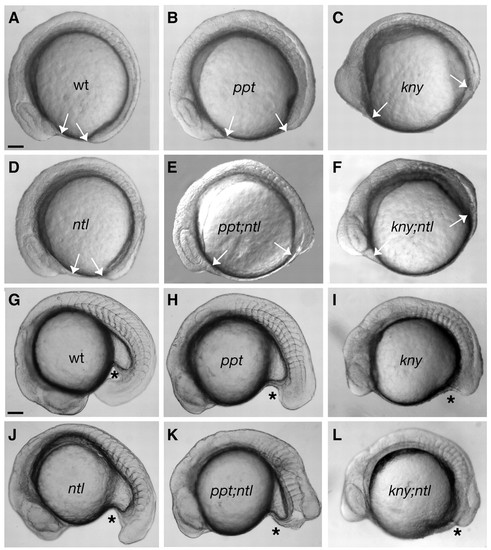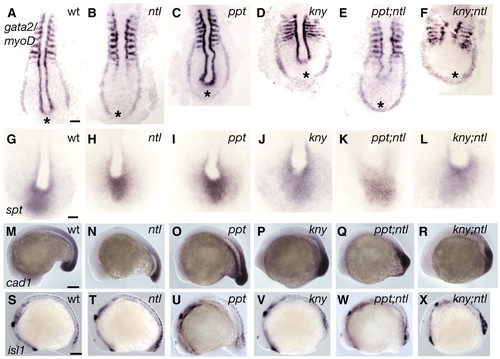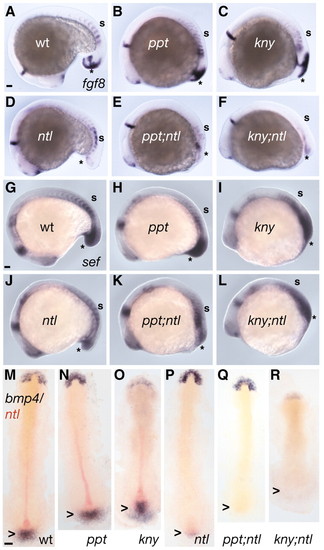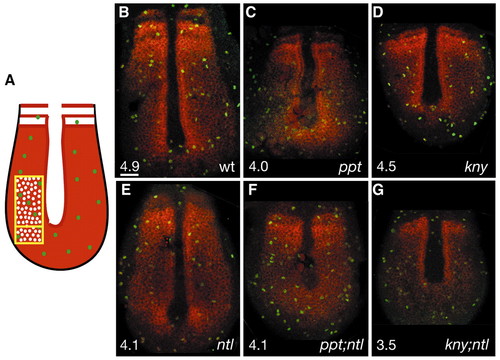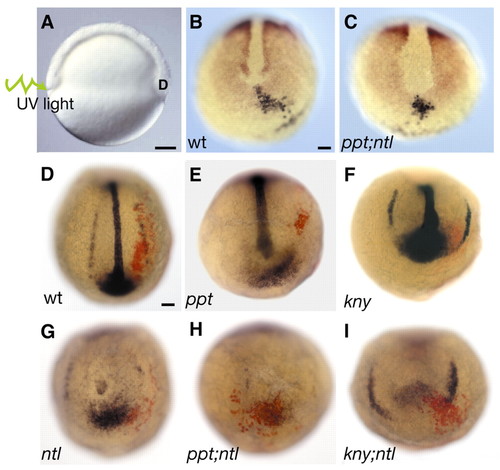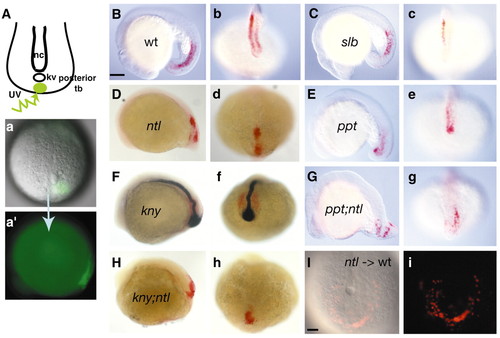- Title
-
No tail co-operates with non-canonical Wnt signaling to regulate posterior body morphogenesis in zebrafish
- Authors
- Marlow, F., Gonzalez, E.M., Yin, C., Rojo, C., and Solnica-Krezel, L.
- Source
- Full text @ Development
|
The ntl gene interacts with kny and ppt, but not slb. At 26 hpf, the tail extends beyond the yolk extension (ye) in wild-type embryos (A). Embryos with the slb mutation (B) have normal tails, whereas ppt (C), kny (D) and ntl (E) embryos have shorter tails (*). Embryos with the slb;ntl double mutation (F) have cyclopic eyes (ey) and tail defects like individual mutants, and slb;ppt (G) double mutants are shorter than individual mutants. The tail does not extend beyond the yolk tube in ppt;ntl (H) and kny;ntl (I) double-mutant embryos. At the ten-somite stage, slb/wnt11 is expressed in the notochord of wild-type (J) embryos but is absent in ntl mutants (K). Posterior ppt/wnt5 expression is mediolaterally broader in wild-type (L) but persists in ntl (M) embryos, and kny expression is comparable between the wild type (N) and ntl mutants (O). (A-I) Lateral views. (J-O) Dorsal posterior views. Scale bar=50 μm (A-I) and 100 μm (J-O). EXPRESSION / LABELING:
PHENOTYPE:
|
|
The ppt;ntl and kny;ntl double mutants exhibit synergistic tail elongation defects. At the eight-somite stage, the AP axis of the wild-type embryo (A) is elongated such that the head and tail almost touch. This distance is greater (arrows) in ppt (B), and kny (C) mutants exhibiting shortened AP axes. In ntl (D) mutants, the AP axis is only slightly shorter at this stage, whereas ppt;ntl (E) and kny;ntl (F) double mutants are shorter than the individual mutants. At 18 somites, the tail extends beyond the yolk tube (*) in wild-type (G) embryos and is shorter in ppt (H), kny (I) and ntl (J) mutants. At this stage, the tail has not extended in ppt;ntl (K) and kny;ntl (L) double mutants. (A-L) Lateral views. Scale bars=100 μm. PHENOTYPE:
|
|
Posterior tissues are specified in ppt;ntl and kny;ntl mutants. At nine somites, myoD is expressed in the somites and adaxial cells, and gta2 is expressed in two bilateral stripes of prospective blood in wild-type (A) embryos. In ntl mutants (B), adaxial cell expression of myoD is lost and the stripes of gta2 are less separated posteriorly. In ppt mutants (C), adaxial cell expression of myoD is kinked and gta2 is similar to the wild type. In kny mutants (D), somites are mediolaterally broader and the AP lengths of adaxial cells and the gta2 domain are shorter. The ppt;ntl (E) and kny;ntl (F) mutants exhibit myoD expression patterns as expected for the combined individual mutants, and gta2 stripes are fused posteriorly. (G-L) Expression of spt in the paraxial mesoderm of wild-type (G), ntl (H), ppt (I), kny (J), ppt;ntl (K) and kny;ntl (L) embryos. (M-R) Expression of Caudal in the tailbud of wild-type (M), ntl (N), ppt (O), kny (P), ppt;ntl (Q) and kny;ntl (R) embryos. (S-X) Expression of isl1 in developing neurons at the 16 somite stage. Ectopic isl1 expression in observed in ntl (T), ppt;ntl (W) and kny;ntl (X) mutants. (A-L) Dorsal posterior flat mounts. (M-X) Lateral views. Scale bars=100 μm (A-F,M-X), 50 μm (G-L). EXPRESSION / LABELING:
|
|
Ntl and non-canonical Wnts synergistically regulate the expression of bmp4, but not Fgf genes. At 16 somites, fgf8 is expressed in the brain and somites, and posteriorly in ectoderm and mesoderm in the wild type (A) and in the ppt (B) and kny (C) mutants. Despite normal anterior fgf8 expression in ntl mutants (D), tail expression is extremely reduced but is not further reduced in ppt;ntl (E) or kny;ntl (F) double mutants. At 16 somites, sef expression in the brain, somites and tail is comparable in wild-type (G), ppt (H) and kny (I) embryos, but is reduced in ntl (J) mutants. Expression of sef is not further reduced in ppt;ntl (K) and kny;ntl (L) mutants. At five somites, bmp4 is expressed in the prechordal plate and tailbud of wild-type (M), ppt (N) and kny (O) embryos. In ntl mutants (P), tailbud expression of bmp4 is severely reduced and is absent in ppt;ntl (Q) and kny;ntl (R) double mutants. (A-L) Lateral views. (M-R) Dorsal flat mounts; arrowheads indicate tailbud. Scale bars=100 μm. EXPRESSION / LABELING:
|
|
Abnormal cell proliferation cannot account for the tail elongation defects in double mutants. Schematic representation of the dorsal medial paraxial region, where the ratio of phosphorylated-histone-positive cells (green) to papc-expressing cells (red) was determined (A). Confocal images of dorsal posterior section of the wild type (B), ppt (C), kny (D) and ntl (E) mutants, and ppt;ntl (F) and kny;ntl (G) double mutants at five somites, phosphorylated-histone-positive cells (green) and papc-expressing cells (red). (B-G) Scale bar=50 μm. EXPRESSION / LABELING:
|
|
Cell movements are impaired in double mutants before the elongation stage of tail morphogenesis. Prospective posterior tailbud cells were labeled 180° from the shield by uncaging with ultraviolet light (A). Labeled cells (black) move to the tailbud region marked by papc expression (red) in wild-type (B) and in single and double mutant embryos, including ppt;ntl (B), at bud stage. At five somites, the position of the labeled cells (red) relative to the ventral derived gta1-expressing cells (blue) was determined. In wild-type embryos (D), labeled cells form elongated arrays that overlap with gta1-expressing cells. In ppt (E), kny (F) and ntl (G) embryos, the labeled cells form shorter arrays that overlap with gta1 expression. By contrast, labeled cells in ppt;ntl (H) and kny;ntl (I) mutants do not form elongated arrays and remain in the posterior bud. (A) Lateral view. (B-I) Dorsal posterior views. Scale bars=100 μm. PHENOTYPE:
|
|
Ntl synergistically interacts with Ppt and Kny to regulate cell movements in the developing posterior body. At one somite, cells within the posterior tailbud were labeled by uncaging with ultraviolet light and, at 18 somites, the position of the labeled cells was determined (A). The labeled cells (red) are within the mesendoderm and lateral to the notochord (ntl in blue) in the wild-type embryos (B,b) and slb mutants (C,c). In ntl mutants (D,d), labeled cells are also within the mesendoderm (D) but are positioned medially (d). In ppt mutants (E,e), the cells occupy the mesendoderm (E) and are lateral to the notochord (e). In kny mutants, cells are within the mesendoderm (F) and lateral to the notochord (f). In ppt;ntl (G,g) and kny;ntl (H,h) mutants, labeled cells are present in both the mesendoderm and ectoderm and fail to move from the posterior bud laterally or to extend (g,h). (B-H) Lateral views. The ntl mutant cells transplanted into wild-type embryos undergo subduction and lateral divergence (I,i). (b-h,I,i) Dorsal posterior views. Scale bar=100 μm. PHENOTYPE:
|

